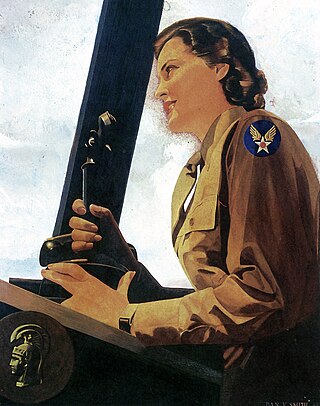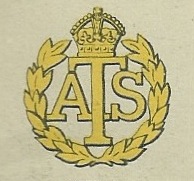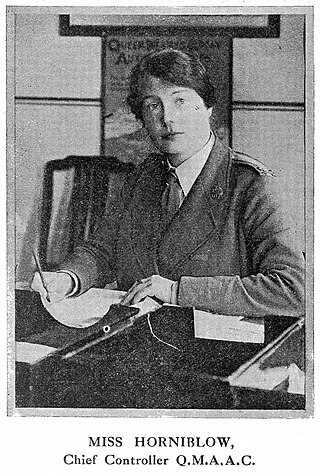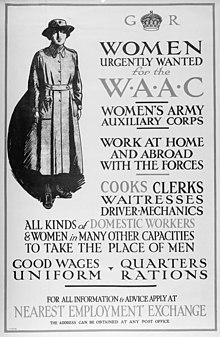
The Women's Royal Army Corps was the corps to which all women in the British Army belonged from 1949 to 1992 except medical, dental and veterinary officers and chaplains, who belonged to the same corps as the men; the Ulster Defence Regiment, which recruited women from 1973, and nurses, who belonged to Queen Alexandra's Royal Army Nursing Corps.

The Women's Auxiliary Air Force (WAAF), whose members were referred to as WAAFs, was the female auxiliary of the British Royal Air Force during the Second World War. Established in 1939, WAAF numbers exceeded 181,000 at its peak strength in 1943, with over 2,000 women enlisting per week.

The Women's Army Corps (WAC) was the women's branch of the United States Army. It was created as an auxiliary unit, the Women's Army Auxiliary Corps (WAAC) on 15 May 1942, and converted to an active duty status in the Army of the United States as the WAC on 1 July 1943. Its first director was Colonel Oveta Culp Hobby. The WAC was disbanded on 20 October 1978, and all WAC units were integrated with male units.

Edith Rogers was an American social welfare volunteer and politician who served as a Republican in the United States Congress. She was the first woman elected to Congress from Massachusetts. Until 2012, she was the longest serving Congresswoman and was the longest serving female Representative until 2018. In her 35 years in the House of Representatives she was a powerful voice for veterans and sponsored seminal legislation, including the Servicemen's Readjustment Act of 1944, which provided educational and financial benefits for veterans returning home from World War II, the 1942 bill that created the Women's Army Auxiliary Corps (WAAC), and the 1943 bill that created the Women's Army Corps (WAC). She was also instrumental in bringing federal appropriations to her constituency, Massachusetts's 5th congressional district.

The Auxiliary Territorial Service was the women's branch of the British Army during the Second World War. It was formed on 9 September 1938, initially as a women's voluntary service, and existed until 1 February 1949, when it was merged into the Women's Royal Army Corps.

Queen Alexandra's Royal Army Nursing Corps was the nursing branch of the British Army Medical Services.
Dame Florence Edith Victoria Simpson, was the senior female British Army officer during World War I and Controller in Chief, later President, Queen Mary's Army Auxiliary Corps.

Dame Helen Charlotte Isabella Gwynne-Vaughan, was a prominent English botanist and mycologist. During the First World War, she served in the Women's Army Auxiliary Corps and then as Commandant of the Women's Royal Air Force (WRAF) from 1918 to 1919. During the Second World War, from 1939 to 1941, she served as Chief Controller of the Auxiliary Territorial Service (ATS).
Dame Louisa Jane Wilkinson, was a British military nurse and nursing administrator who served as Matron-in-Chief of the Queen Alexandra's Imperial Military Nursing Service from 1944 to 1948. She founded Queen Alexandra's Royal Army Nursing Corps, and was also president of the Royal College of Nursing.

Alexandra Mary Chalmers Watson CBE,, known as Mona Chalmers Watson, was a British physician and head of the Women's Army Auxiliary Corps. The first woman to receive an MD from the University of Edinburgh, she helped found the Elsie Inglis Hospital for Women, was the first president of the Edinburgh Women's Citizen Association, a staff physician and later senior physician at the Edinburgh Hospital and Dispensary for Women and Children, and co-edited the Encyclopaedia Medica with her husband, Douglas Chalmers Watson. At the time of her death in 1936, she was president of the Medical Women's Federation, having been elected May 1935.

Phoebe Chapple MBBS BSc was a South Australian medical doctor, decorated for her heroic service in France during World War I.

Emilie Hilda Dalton, was an English army officer and teacher.

Beatrice Ethel Lithiby OBE was a British artist known as a painter and designer of stained glass and church furnishings. She served in both World War I and World War II in the British Army and in the former conflict also worked as a war artist for the Imperial War Museum.

The Women's Royal Air Force (WRAF) was the women's branch of the Royal Air Force, existing from 1 April 1918 until 1 April 1920, when it was disbanded. Its original intent was to provide female mechanics in order to free up men for front line service in World War I. However, the organisation saw high enrolment, with women also serving in a number of other non-combatant roles, including drivers, caterers, clerks and tailors, as well as filling other wartime needs.
Reginald George Shelford "Ginger" Bidwell, was a British Army officer and military historian.

The Women's Auxiliary Army Corps was a female auxiliary of the New Zealand Military Forces. Raised during the Second World War under the command of Vida Jowett, most of its personnel served on the Home Front, with several manning coastal and anti-aircraft defences. Many WAACs were sent overseas to serve in Europe and the Middle East, mainly providing medical and welfare services to the troops of the 2nd New Zealand Expeditionary Force. At its peak, it had a strength of nearly 4,600 serving personnel. After the war, some WAACs served with Jayforce, providing welfare services for the New Zealand troops doing occupation duties in Japan.
Alice Low, (1877–1954) was a British suffragist, who spoke up for peaceful means of achieving women's rights to vote, and fairer laws, including reducing sweated labour. She was a leader in Edinburgh and Berwickshire National Union of Women's Suffrage Societies (NUWSS) and a touring speaker in the early twentieth century. She was also a lead member of Queen Mary's Army Auxiliary Corps. (QMAAC) in World War One and an amateur actress taking lead roles with the British Empire Shakespeare Society.
The Hush WAACs were a group of seventeen British women who worked on the front line as codebreakers in France during World War One. After the war, two would go on to work on diplomatic codebreaking for MI1b. Although women were already working as codebreakers in Room 40 and MI1b, the Hush WAACs were the only women to serve as codebreakers at the front line during WW1.

Mabel Dymond Peel was an English codebreaker who served with the Hush WAACs during World War I. She is better-known than her colleagues in this secretive group because of her memoir, The Story of the Hush-WAACs, published in 1921. Outside of wartime she worked as a languages teacher and established the Rouen branch of the Royal British Legion.
MI1(b) was a department of British Military Intelligence set up during World War I for the interception and cryptanalysis of coded messages. Unlike its equivalent in the Admiralty, Room 40, where women were employed in clerical roles, MI1(b) employed women as linguists, translators, and cryptanalysts. By 1919, a third of MI1(b)’s civilian cryptanalysts and linguists were women.



























